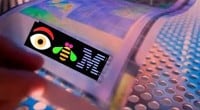IBM EYE-EYE PAD DESTROYS THE ENTIRE VALUE CHAIN

From designer straight to desk-top manufacturing at the point of usage
- Dateline
- 17 June 2020
Over the past two decades we have become used to our consumer electronics being made in Asia.
Even though there are ever-more disturbing reports of inhuman conditions in Asian factories, including the latest suicides and murders to cover up corrupt practices, companies such as Apple have had no alternative to producing in these low-wage economies.
Yesterday, IBM announced its first venture into consumer electronics since the sale of their PC ThinkPad division to Lenovo in 2004, and sounded the start of what could be the end of Asian manufacturing dominance.
At first sight, the Eye-Eye Pad is a throw-back to the iPhone of a decade ago – just much thinner and flexible so that it can live comfortably in your shirt or trouser pocket. It has no battery and gets all its energy from ambient light – an OLED Display and carbon wiring makes it possible. The US$20 retail price seems impossibly cheap. “That wouldn’t even cover the cost of postage!” thundered one blog.
But, what really makes it different is that IBM have eliminated the entire production and logistics value chain. You order your product on-line and it is printed in your home or office on a 3D ink-jet printer.
IBM partner HP has new pricing including “A free 3D printer with every five cartridges you buy.” The cartridges of course do not contain ink, but the plastics and metals used to ‘print’ whatever you choose.
Within the next year your home/office 3D printer could print virtually anything – a watch, cutlery, some food items and perhaps soon, a cheeseburger!
The revolution in 3-D printing technologies has come a very long way. The ‘factory’ has literally moved from Asia to the point of usage, in the home or workplace. Personal devices now have capabilities that would have been unimaginable at an industrial level a decade ago.
Welcome to the new Industrial Revolution. The ‘old’ way of manufacturing and distribution will never be the same again.
These industries will be redefined, as well as the logistics, wholesale and retail industries. Asia’s future will require a step-change in thinking as the old value chains into the economies of The West disappear for ever.
ANALYSIS >> SYNTHESIS: How this scenario came to be
Background:
3-D prototyping machines, sometimes coupled with lasers, have been used in design shops and architectural offices for years, mostly to create rough 3-D models from computer-generated CAD/CAM designs. These prototypes were made from various kinds of resins hardened by computer-targeted lasers and were typically not operational models. They did however serve an important purpose to get clients to visualize and experience the final product without complex and expensive tooling operations.
Now, using ink-jet technology commonly found in the cheapest of color printers, these prototyping technologies have become so sophisticated that they can build working prototypes of mechanical devices and entire microprocessors.
Links to related stories
- MEGA 3D Printer To Create World's First Printed Building - WonderHowTo.com, 16 March 2010
- Printing Organs: A presentattion at TED by Wake Forest University - January 2010
- Thinner, faster and pocket-sized: OLED screens and 3D printers - The Telegraph, 7 August 2009
- Thumbs up for 3D bone printer: Exact replicas of a man's thumb bones have been made for the first time using a 3D printer - New Scientist 7 March 2009
- Gadget printer promises new industrial revolution, New Scientist 8 January 2003
- MindBullet: PRINTING - THE FUTURE OF MANUFACTURING (Dateline: 17 June 2012, Published: 10 June 2004)
- Wikipedia: 3D Printing
- MindBullet: FOOD IS NOTHING BUT I.P. (Dateline: 12 October 2023, Published: 08 July 2010)
Warning: Hazardous thinking at work
Despite appearances to the contrary, Futureworld cannot and does not predict the future. Our Mindbullets scenarios are fictitious and designed purely to explore possible futures, challenge and stimulate strategic thinking. Use these at your own risk. Any reference to actual people, entities or events is entirely allegorical. Copyright Futureworld International Limited. Reproduction or distribution permitted only with recognition of Copyright and the inclusion of this disclaimer.